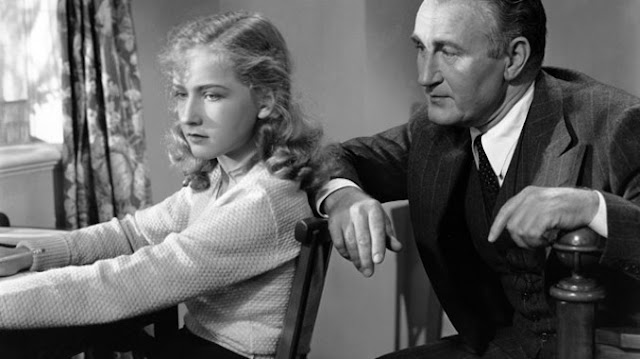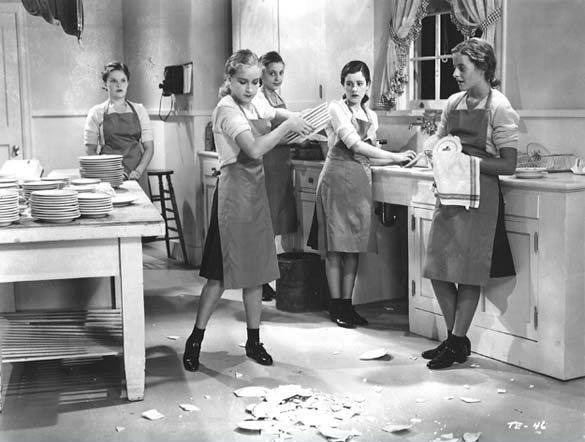 |
| Robert Mitchum and Jane Greer on the set of Out of the Past (1947) |
Out of the Past (1947) was based on the 1946 novel Build My Gallows High by Geoffrey Homes, a pen name for author Daniel Mainwaring. The film rights were up for auction before the novel was even published. RKO's William Dozier beat out Warner Bros. with the winning bid. Although the book was released as Build My Gallows High, that title wasn't quite right for the movie. A Gallup poll conducted by RKO confirmed that such a morbid title would scare off potential viewers. The name change to Out of the Past happened after filming was wrapped up.
RKO brought Mainwaring on board to work on the screenplay. He took a crack at it but it proved to be too complicated a story and the flashback structure just wasn't working. Various sources say that author James M. Cain (Postman Always Rings Twice) also attempted to write the screenplay by making numerous changes to Mainwaring's story and characters. Director Jacques Tourneur read both screenplays and requested his own changes. A third writer, Frank Fenton, solidified the structure and added some colorful dialogue. Although multiple screenwriters worked on the adaptation, only Mainwaring (as Geoffrey Homes) received credit. In the end Tourneur still thought the final product was confusing but went ahead with the production anyways.
Originally Edward Dmytryk was announced as director but a scheduling conflict with the filming of So Well Remembered (1947) caused him to drop out. Jacques Tourneur recently had some success at RKO making pictures with Val Lewton and came on board as director bringing cinematographer Nicholas Musuraca with him. They had previously collaborated on the RKO film Cat People (1942).
 |
| Jacques Tourneur and Nicholas Musuraca meeting with Jane Greer and Robert Mitchum. Out of the Past (1947) |
Mainwaring first envisioned Humphrey Bogart for the part of Jeff Bailey. He even went so far as to meet with Bogart and present him with the script. Bogart might have been interested but his studio Warner Bros. wouldn't loan him out with RKO. Was Warner Bros. bitter because they lost the auction? Perhaps. However, the story from Warner Bros. was that Bogart was far too busy with other projects and they couldn't possibly loan him out. Other actors were considered including Dick Powell, Pat O'Brien and John Garfield. RKO finally settled on Robert Mitchum, their contract up-and-comer who could work on the cheap. Mitchum had potential as a leading man; he just needed a opportunity to show his worth. The role of Jeff Bailey matched Mitchum's personality. It was a natural fit.
RKO built a cast of relative newcomers to round out of the film. These included Kirk Douglas, Jane Greer, Virginia Huston, Rhonda Fleming, and Paul Valentine. Former child actor Dickie Moore, who'd recently recovered from a crippling virus that put his acting career on hold, was signed on for the part of the deaf-mute "kid". He spent four weeks learning sign language for the part. Mitchum was paid around $10k for over 10 weeks of work in comparison to Kirk Douglas who was on loan from Paramount and received $25k for a much smaller role. Jane Greer, who was Howard Hughes' discovery, was just 22 when she landed the femme fatale role of Kathie. It was a great part for her and boosted her confidence in her acting abilities.
The crew set out to Bridgeport, California, a small town in the Sierra Mountains to scout out locations and start filming. Out of the Past was shot in Bridgeport, Upper Twin Lake, Lake Tahoe and even San Francisco. (Check out Laura's awesome post about the different Bridgeport locations featured in Out of the Past.)
A week later Mitchum flew out to Bridgeport in what turned out to be one of the most dramatic entrances and proves sometimes the truth is stranger than fiction. Mitchum biographer Lee Server recounts that RKO's Warren Duff and Robert Mitchum took a four-seater plane out to Bridgeport. As they landed, the wheels hit the runway but plane wouldn't slow down because the brakes had failed. The pilot tried with all his might to stop the plane. Server says "the aircraft smashed through a fence, hopped a ditch, and knocked over an outhouse before it came to a complete stop." Mitchum and Duff were knocked unconscious but no one was seriously injured. Who else can say they arrived for a film shoot by way of a crash landing?
Once settled, the cast and crew would film in Bridgeport for three weeks. There wasn't much to do in town. During their free time, they'd hang out at a local tavern. According to Server, "RKO sent up a projector and some spare prints, so in the evening people would gather around and watch Tom Conway as The Falcon..." RKO's publicist arranged for Mitchum to be involved in a publicity stunt. Mitchum, who was part Native American, was initiated into the Shoshone Indian tribe complete with headdress and photo op. When he wasn't at the beck and call of RKO, he'd write poetry and share it some of his fellow cast members including Dickie Moore. Newcomer Virginia Huston developed a massive crush on Mitchum and I can't say I blame her.
 |
| Robert Mitchum and Jane Greer - Out of the Past (1947) |
After the location shooting wrapped up, the whole unit traveled back to Los Angeles to film the remaining scenes at the RKO lot. That's when the rest of the cast including Jane Greer and Kirk Douglas, started working. Mitchum and Jane Greer got a long really well on set and soon became fast friends. Their friendship would last for decades. According to a few sources, Mitchum and Kirk Douglas got along fine but there was a professional rivalry between the two. They both played to the camera in an effort to steal a scene or two. This rivalry would continue for years but on a low-key basis with both figures being dismissive of the other. But it's not like Mitchum would admit to this. In an interview with Jerry Roberts, Mitchum was asked about tensions on set and his response was, "Hell no. We had just seen him in The Strange Love of Martha Ivers and were all delighted that he was in the picture." Director Tourneur and Mitchum were a match made in heaven. Tourneur found in Mitchum what he was looking for: an actor who was charismatic yet reserved and whose good looks and personality would bring a dreamy sensuality to Jeff Bailey.
 |
| Kirk Douglas and Robert Mitchum in Out of the Past (1947) |
Production wrapped up in January of 1947 but Out of the Past wasn't released until November of that year. In the midst of filming, RKO had hired Dore Shary as head of production. He dismissed basically every project RKO was working on before he was hired and Out of the Past suffered as a result. The film was released with little to no publicity. It made a modest profit for the studio but it wasn't considered the great classic it is today. In fact, it wasn't until decades later when Film Noir was defined and studied as a genre that Out of the Past was truly appreciated.
Out of the Past has had various home video releases over the years. It's currently available in a stunning blu-ray edition available from the Warner Archive Collection.
Sources
Baby I Don't Care: Robert Mitchum by Lee Server
Robert Mitchum In His Own Words edited by Jerry Roberts
TCMDB Article Laura of Laura's Miscellaneous Musings

















